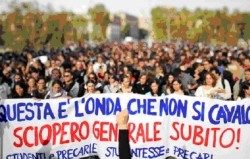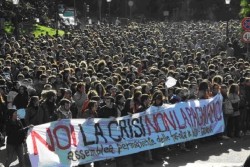In Italy one of the strongest student movements of recent past keeps growing, as protests started in September when the Berlusconi government and its Education Minister Mariastella Gelmini announced their public school and universities reform plan.
the Berlusconi government and its Education Minister Mariastella Gelmini announced their public school and universities reform plan.
According to the financial plan law approved in the end of September, there will be 8 billion euro decrease in state investments for public schools and about 1.5 billion expense cut for public universities in coming years. This means a strong reduction in teacher number and in lesson time, especially in elementary schools; making it more difficult for mothers to work and, in the mean time to take care of their children. Another highly criticized law, proposed by far-right xenophobic Lega Nord Party, aims to create separate classes for immigrant children in primary schools.
Universities
On the other hand the government decided to block recruitment of new professors in the universities. In the next years it will be possible to hire only one new professor for every five retired. Public universities will be also turned in private foundations in order to be able to raise funds from private sponsors.
 Critics say this would result in a growing influence of private companies on university research jeopardizing its independence and objectivity. Students claim university public expense cut will result in a strong university tax raise and that Berlusconi uses school and university money to save banks and to increase military expenses.
Critics say this would result in a growing influence of private companies on university research jeopardizing its independence and objectivity. Students claim university public expense cut will result in a strong university tax raise and that Berlusconi uses school and university money to save banks and to increase military expenses.
Since September a wide opposition movement has grown day by day, school teachers and university researchers who fear they will lose their job, parents who think the education system quality will strongly decrease, students who are convinced they will pay higher taxes to study in low quality universities that won’t give them the necessary knowledge to find and appropriate job, are protesting.
Protests
After the financial plan passed, minister of education announced the school reorganization law would have been voted by the parliament in the end of October, protests grew all over the country, with the aim of blocking the law and to force the government to retire his decision to cut education expenses. Schools where squatted, local rallies were organized and on the 30th a mass demonstration took place in Rome and Bologna, organized by the most important school trade unions, COBAS, CGIL, CISL UIL.
More then a million students marched to defend public school and universities and teachers went on a national strike. In October when the education law was voted, thousand of students in Rome besieged the parliament to block the vote. After the law passed the student movement continued to protest against the government.
University students are the main protagonists of the protest, shouting slogans like: “If you block our future, we will block the city”, “we won’t pay for your crisis.” They adopt a wide-rage of way of protests, like occupying faculties, sit-ins on the railways to block the trains and in the main city streets to stop the traffic. A lot of university professors supported the protest and organized open-air lessons in the main city central squares to involve citizens in the protestation.  Students denounce Berlusconi's plans to use public school and university funds to help banks and to increase military budget.
Students denounce Berlusconi's plans to use public school and university funds to help banks and to increase military budget.
Public support
According to an opinion pull published on one of the most read Italian news-papers, La Repubblica, public support toward the students is high and this fact worries the government to see the consensus decreasing day by day. So the minister of education tried to find a solution to the first crisis after Berlusconi was elected in April. She issued a new law that softens the previous one, then asked the trade unions to cancel the national strike planned for Friday 14th.
For the main trade union CGIL and the student movement this wasn't enough, they refused to postpone the meeting asking the government to withdraw all laws concerning education issued during these months.
In Rome on Friday marched 500.000 people, during the protest parliament was put under siege, Italian students held sit-ins and demonstration in front of Italian embassies in London, Berlin, Paris, Madrid, Granada, Valencia, Lyon, Wien, Brussels, Copenhagen and Amsterdam.
Around 30 Italian students demonstrated also in Istanbul in front of Italian consulate in Beyoğlu, three of the protester met the Consul Stefano Canzio who sent a fax to Italian Education Ministry reporting about student the protest.Italian student movement calls itself "the anomalous wave" to underline its self-organized nature and its independence from political parties. The wave untill now, doesn’t stop to grow.(AT/EÜ)





